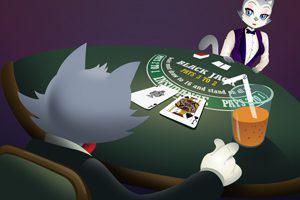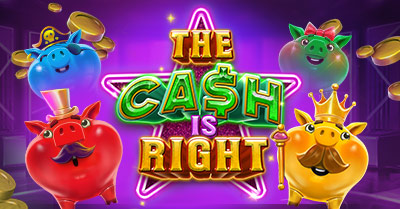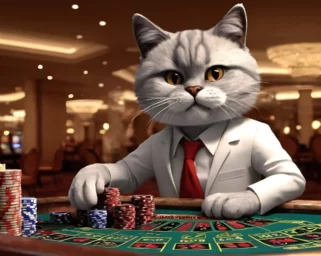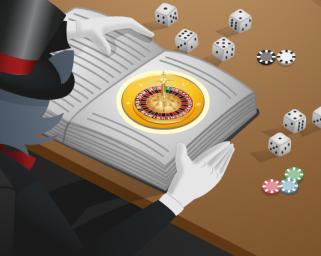The casinos had never seen anything like Keith Taft. An unsuspecting family wanders in off the Reno Strip, and finds a sure-fire way to beat the house. It looks like a regular night out at the casino tables. But it is actually a carefully crafted sting operation, involving secret signals, wires and a hidden computer, all designed to help one man make the right bets. That man is Keith Taft.
On an October night in 1976 in Reno, Nevada, Keith Taft and his group of card counters decide to hit the blackjack tables. One of these men is his 20-year old son Marty.
Two men approach the blackjack dealer to play. As the action starts picking up, another man known as ‘the big player’ makes a handsome bet of $1,000. Over the course of just a few hours, everyone at the table is winning, amassing tens of thousands of dollars. It must be their lucky night. However, as the pit bosses will soon realize, something much more sinister is at work.
Before the night is over, casino management senses foul play and decide to grab young Marty into a backroom for questioning. Their suspicions were correct. They lift the man’s shirt to find a device strapped to his body, which is sending him secret messages. Young Marty is beginning to sweat, and he asks himself, “How did I get into this predicament?” Join us as we share with you the fascinating tale of Keith Taft – Blackjack legend and computer genius.
Beat the Dealer
 In 1969, Keith Taft was a full-time mechanical engineer working at the Raytheon Plant in Mountain View, California. Happily married with two kids, Taft was a devoutly religious man, who loved the church as much as he loved inventions. On one fateful night however, everything changed. He walked into a casino for the first time in his life in Reno. The sights and sounds, the buzz in the atmosphere; people gambling, laughing and the clinking of casino chips. Taft had no clue how to play any of the games, but something in him yearned to understand their inner workings. He decides to walk up to a blackjack table and asks the dealer how to play.
In 1969, Keith Taft was a full-time mechanical engineer working at the Raytheon Plant in Mountain View, California. Happily married with two kids, Taft was a devoutly religious man, who loved the church as much as he loved inventions. On one fateful night however, everything changed. He walked into a casino for the first time in his life in Reno. The sights and sounds, the buzz in the atmosphere; people gambling, laughing and the clinking of casino chips. Taft had no clue how to play any of the games, but something in him yearned to understand their inner workings. He decides to walk up to a blackjack table and asks the dealer how to play.
Before he knows it, he is hooked. He had never gambled before in his life or even toyed with notion. But as an engineer and inventor, he had a fondness for numbers, and blackjack was the perfect fit. How does a devoutly religious man decide to frequent the casinos of Reno? He owed it all to one book, Beat the Dealer by Ed Thorp.
Published in 1966, Beat the Dealer took the gambling world by storm. It crushed the notion that blackjack was a gambling game about luck, but instead relied purely on mathematics. If a player was clever enough, they could utilize a mathematical formula to beat the house. Thorp, a UC Irvine professor and math wizard, had developed a system known as “card counting”. The beauty was that if applied correctly a player could increase their play advantage in blackjack against any casino.
This was a revolution for would-be gamblers and cardsharps. Players from all over the country were desperate to get their hands on the bestseller. One such individual was the impressionable and highly intelligent Keith Taft.
Mastering the Count
 Counting cards is a simple, but highly effective strategy that utilizes a “hi-lo system”. Cards are given the following values: 2-6 are given a value of +1 (plus one), 7-9 equal 0 (zero), and 10-Ace are equivalent to -1 (minus one). As cards are dealt, a player establishes a running count in order to determine how many high denomination cards remain in the deck.
Counting cards is a simple, but highly effective strategy that utilizes a “hi-lo system”. Cards are given the following values: 2-6 are given a value of +1 (plus one), 7-9 equal 0 (zero), and 10-Ace are equivalent to -1 (minus one). As cards are dealt, a player establishes a running count in order to determine how many high denomination cards remain in the deck.
If the value is low, the player bets small. If the value is high players must bet big. In theory, with appropriately timed bets, players can earn a fortune counting cards. The trick is to master an effective count. Having read Thorp’s book, Taft had an epiphany. Instead of performing the mathematics and the task of memorizing numbers in his head, he would build a computer that could do the counting for him. As a mechanical engineer and amateur inventor, he had all the right tools to turn his idea into a reality. And into cold, hard cash.
Building a Better Mouse Trap
Back in California, Taft took built a computer in his spare time that could card count with the intention to use it in a casino. The computer had to be small enough to sneak into a casino undetected by security and the dealer. He did precisely that.
After learning the basic strategy of card counting, Taft constructed a device that fit into the soles of a pair of shoes. He attached triggers to his toes that he would use to input manually the value of the cards the dealer would lay in front of him in binary form. The triggers were attached via wires to a computer-device strapped to his body. The four switches reflected the card values, one above and below each of his big toes. One switch counted a value of one, another counted a value of two, the third counting a value of four, and the final a value of eight. With this method, he could put in any combination of numbers used in blackjack.
With the device computing the appropriate card counting value, he could accurately determine when to hit and when to stay, all performed in a matter of seconds.
To get good at inputting numbers to receive a response, Taft practiced using his device while driving in his car. He would read the license plates of cars in traffic to get faster at inputting the running count. Once the computer had calculated the card-counting value, the signal to bet big or small flashed via three colors (green, red, and orange) reflected inside of a pair of glasses he wore. In single-deck conditions, Taft now knew exactly how to bet and gained a 3.5% edge over the house all thanks to his device named “George”.
Risks and Reward
 From the beginning, Taft knew of the risks involved if casino security caught him in the act. In those days, many of the casinos in Las Vegas and particularly in Reno were mob-owned. Countless stories involved casino cheaters taken into backrooms, beaten into a pulp, only to be tossed into a back alley and robbed of their winnings. Yet for some reason, Taft saw himself more as an opportunistic businessperson than a cheater. He felt that he was not directly marking cards or influencing the dealer, but merely outsmarting them at their own game by using all of the methods at his disposal.
From the beginning, Taft knew of the risks involved if casino security caught him in the act. In those days, many of the casinos in Las Vegas and particularly in Reno were mob-owned. Countless stories involved casino cheaters taken into backrooms, beaten into a pulp, only to be tossed into a back alley and robbed of their winnings. Yet for some reason, Taft saw himself more as an opportunistic businessperson than a cheater. He felt that he was not directly marking cards or influencing the dealer, but merely outsmarting them at their own game by using all of the methods at his disposal.
Despite the dismay of his wife, Taft felt he had the chops to test his device at the casinos’ blackjack tables, and to quote Thorp, beat the dealer. In his eyes, the reward was worth the risk.
Taft had to make sure his machine worked. But he also had to develop skills of camouflage to stay hidden under the noses of the pit bosses who roamed the casino floors like hounds. As he approached the casinos of Reno in 1970, Taft circled the blackjack tables, device at the ready and strapped to his stomach. He was looking for what he called “ideal playing conditions”. This was where the dealer was not dealing too fast, and table limits were high. Having made the trip from his home in Sunnyvale, California to Reno, Nevada, and with his blackjack strategy on hand, Taft was ready to play blackjack.
Are you ready to start winning big with blackjack online? Simply head over to our exciting table games section and sign in, with a small deposit you’ll be hitting those aces and face cards in no time!
In It to Win It
Taft’s goal was to reach $200,000 in blackjack winnings in order to quit his job and become a full-time inventor. He began by betting small, accomplishing a highly successful win rate using his new device.
Things went smoothly at first. But he soon realized that he would have to up the ante to see any significant returns with his blackjack strategy. With counting cards, he felt the pressure, as his wife discouraged his newfound hobby; worried about the potential demons that gambling reflected. As a man of morals; these thoughts weighed heavy on poor Taft’s conscience. Yet he still thought he could do no wrong, arguing that the potential winnings would help provide for his family, and begin his life anew.
In order to make big money, Taft started taking bigger risks; increasing single wagers into thousands. However, he would learn the hard way that over a short period that his wins were merely a matter of luck. His odds were no better whether he used “George” or not.
As a math expert, he knew that the laws of probability would catch up, and that his machine was infallible. There was just one catch: he did not possess the proper funds to overcome heavy losses.
Not long after a series of runs at the Reno blackjack tables, Taft found himself over $4,000 in the hole. This was not just his money, but also his family’s money, his kids’ college tuition. He could not bear the guilt of losing any more. Taft returned home to California with head hung low, and his tail between his legs. He decided to retire his machine, and gave up his efforts of counting cards.
An Unlikely Partnership
 In 1975, Taft, who was convinced he would never gamble again, became the subject of a news article for the San Jose Mercury News where he described his efforts with “George” and his failed attempts at counting cards. Everyone assumed that hardly anyone would read the article in question. But not long after its publication, one of the most famous blackjack card counters of all time contacted him. It was none other than Ken Uston.
In 1975, Taft, who was convinced he would never gamble again, became the subject of a news article for the San Jose Mercury News where he described his efforts with “George” and his failed attempts at counting cards. Everyone assumed that hardly anyone would read the article in question. But not long after its publication, one of the most famous blackjack card counters of all time contacted him. It was none other than Ken Uston.
Uston was a notorious cardsharp throughout the 70s and 80s. His team of counters managed to win millions of dollars from the various casinos throughout Las Vegas and Atlantic City. Taft agreed to meet with Uston, after Uston convinced him to consider counting cards again. He proposed a deal that offered 10% of any future card counting winnings from his team in exchange for five new devices.
A Shaky Beginning
The original plan was for Taft to teach Uston’s players how to use the devices in conjunction with Uston’s card counting blackjack strategy. However, they soon learned that none of the members of Uston’s team could use the device as well as Taft or his son. Taft and his son Marty, at his own request, would have to participate in Uston’s game. Together, they had the potential to take on the casinos for hundreds of thousands of dollars, potentially millions. Nothing could stop Taft and Uston, and their team was off to Las Vegas.
They used a deceptive, three-person blackjack strategy. Two members of the card counting team sat equipped with the devices, now dubbed “David”, from the Biblical story of David and Goliath. They would sit at a blackjack table and start counting cards and placing bets. They used subtle hand gestures to signal the “big player”, a supposed stranger, who at a critical point in the deal, would approach the blackjack table and place a massive bet. The results were phenomenal.
Lame to Fame
 Within months, the team was reporting an 80% success rate, and earning hundreds of thousands of dollars as they moved from casino to casino. Uston, who was no stranger to big action, was in his element and the team split the pot.
Within months, the team was reporting an 80% success rate, and earning hundreds of thousands of dollars as they moved from casino to casino. Uston, who was no stranger to big action, was in his element and the team split the pot.
To the chagrin of Taft, Uston and his team started taking bigger and bigger risks at the blackjack tables, with Uston’s team eventually dropping out. Although counting cards is legal, casinos heavily discourage it; treating potential card counters to their infamous “backroom treatment” and adding them to a blacklist.
Caught in the Act
After feeling too much heat from the casinos of Las Vegas, Taft, his son Marty and Uston headed over to Lake Tahoe in the north. On a fateful night of heavy card counting, casino staff caught on to the team’s antics, and Taft’s son Marty was caught in the act. The police were called, which led to an eventual investigation by the FBI.
During the 1970s, there was no law in place to ban the use of devices or computers to aid gamblers in casinos. A court ruled that the device was not a form of cheating, and thus a legal. However, the incident was enough to scare off Marty from card counting for good.
By the 1980s, Uston had been banned from nearly every major casino within the U.S., and Taft received 60 days in prison after constructing a device that secretly recorded dealers’ cards using a small video device. Taft finally decided to give up card counting for good. For the sake of beating the dealer in blackjack, Taft risked his faith, family and future, yet managed to walk away unscathed, and even with a little extra coin in his pocket. In 2004, Taft was inducted into the Blackjack Hall of Fame, and passed away two years later.
Conclusion
Blackjack truly is a remarkable game, and is very easy to learn. Once you have mastered the ins and outs of blackjack, why not test your luck at the blackjack online tables at CoolCat casino! We have a wide offering of incredible online casino games, sure to get you ready to play blackjack. Win big on Perfect Pairs and Super 21 to beat the dealer and win big. You can choose to play free using the Instant Play feature or make a minimum deposit to earn those big gambling dollars.



























